Association is a relation between two separate classes which is established through their Objects. Association can be one-to-one, one-to-many, many-to-one, many-to-many. In Object-Oriented programming, an Object communicates to another object to use functionality and services provided by that object. Composition and Aggregation are the two forms of association.
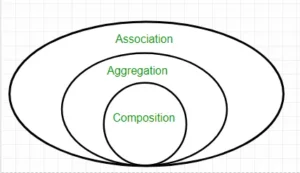
Association
Ex:
1 2 3 4 5 6 7 8 9 10 11 12 13 14 15 16 17 18 19 20 21 22 23 24 25 26 27 28 29 30 31 32 33 34 35 36 37 38 39 40 41 42 43 44 45 46 47 48 49 50 51 52 53 54 55 56 57 58 59 60 61 62 63 64 65 66 67 68 69 70 71 72 73 74 75 76 77 78 79 80 81 82 83 84 85 86 87 88 89 90 91 92 | // Java Program to illustrate the // Concept of Association // Importing required classes import java.io.*; import java.util.*; // Class 1 // Bank class class Bank { // Attributes of bank private String bankName; private Set<Employee> employees; // Constructor of Bank class public Bank(String bankName) { this.bankName = bankName; } // Method of Bank class public String getBankName() { // Returning name of bank return this.bankName; } public void setEmployees(Set<Employee> employees) { this.employees = employees; } public Set<Employee> getEmployees() { return this.employees; } } // Class 2 // Employee class class Employee { // Attributes of employee private String name; // Constructor of Employee class public Employee(String name) { // this keyword refers to current instance this.name = name; } // Method of Employee class public String getEmployeeName() { // returning the name of employee return this.name; } } // Class 3 // Association between both the // classes in main method class AssociationExample { // Main driver method public static void main(String[] args) { // Creating Employee objects Employee emp1 = new Employee("Ridhi"); Employee emp2 = new Employee("Vijay"); // adding the employees to a set Set<Employee> employees = new HashSet<>(); employees.add(emp1); employees.add(emp2); // Creating a Bank object Bank bank = new Bank("ICICI"); // setting the employees for the Bank object bank.setEmployees(employees); // traversing and displaying the bank employees for (Employee emp : bank.getEmployees()) { System.out.println(emp.getEmployeeName() + " belongs to bank " + bank.getBankName()); } } } |
Output:
1 2 | Ridhi belongs to bank ICICI Vijay belongs to bank ICICI |
Explanation of the above Program:
In the above example, two separate classes Bank and Employee are associated through their Objects. Bank can have many employees, So, it is a one-to-many relationship.
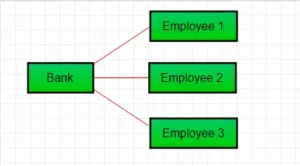
Aggregation
It is a special form of Association where:
- It represents Has-A’s relationship.
- It is a unidirectional association i.e. a one-way relationship. For example, a department can have students but vice versa is not possible and thus unidirectional in nature.
- In Aggregation, both entries can survive individually which means ending one entity will not affect the other entity.
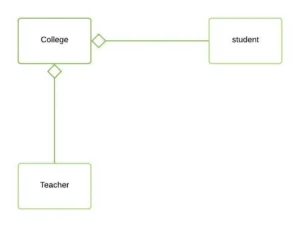
Ex:
1 2 3 4 5 6 7 8 9 10 11 12 13 14 15 16 17 18 19 20 21 22 23 24 25 26 27 28 29 30 31 32 33 34 35 36 37 38 39 40 41 42 43 44 45 46 47 48 49 50 51 52 53 54 55 56 57 58 59 60 61 62 63 64 65 66 67 68 69 70 71 72 73 74 75 76 77 78 79 80 81 82 83 84 85 86 87 88 89 90 91 92 93 94 95 96 97 98 99 100 101 102 103 104 105 106 107 108 109 110 111 112 113 114 115 116 117 118 119 120 121 122 123 124 125 126 127 128 129 130 131 132 133 134 135 136 137 138 139 140 141 142 143 | // Java program to illustrate // Concept of Aggregation // Importing required classes import java.util.*; // Class 1 // Student class class Student { // Attributes of Student private String studentName; private int studentId; // Constructor of Student class public Student(String studentName, int studentId) { this.studentName = studentName; this.studentId = studentId; } public int getstudentId() { return studentId; } public String getstudentName() { return studentName; } } // Class 2 // Department class // Department class contains list of Students class Department { // Attributes of Department class private String deptName; private List<Student> students; // Constructor of Department class public Department(String deptName, List<Student> students) { this.deptName = deptName; this.students = students; } public List<Student> getStudents() { return students; } public void addStudent(Student student) { students.add(student); } } // Class 3 // Institute class // Institute class contains the list of Departments class Institute { // Attributes of Institute private String instituteName; private List<Department> departments; // Constructor of Institute class public Institute(String instituteName, List<Department> departments) { // This keyword refers to current instance itself this.instituteName = instituteName; this.departments = departments; } public void addDepartment(Department department) { departments.add(department); } // Method of Institute class // Counting total students in the institute public int getTotalStudentsInInstitute() { int noOfStudents = 0; List<Student> students = null; for (Department dept : departments) { students = dept.getStudents(); for (Student s : students) { noOfStudents++; } } return noOfStudents; } } // Class 4 // main class public class AggregationExample { // main driver method public static void main(String[] args) { // Creating independent Student objects Student s1 = new Student("Parul", 1); Student s2 = new Student("Sachin", 2); Student s3 = new Student("Priya", 1); Student s4 = new Student("Rahul", 2); // Creating an list of CSE Students List<Student> cse_students = new ArrayList<Student>(); cse_students.add(s1); cse_students.add(s2); // Creating an initial list of EE Students List<Student> ee_students = new ArrayList<Student>(); ee_students.add(s3); ee_students.add(s4); // Creating Department object with a Students list // using Aggregation (Department "has" students) Department CSE = new Department("CSE", cse_students); Department EE = new Department("EE", ee_students); // Creating an initial list of Departments List<Department> departments = new ArrayList<Department>(); departments.add(CSE); departments.add(EE); // Creating an Institute object with Departments list // using Aggregation (Institute "has" Departments) Institute institute = new Institute("BITS", departments); // Display message for better readability System.out.print("Total students in institute: "); // Calling method to get total number of students // in the institute and printing on console System.out.print( institute.getTotalStudentsInInstitute()); } } |
Output:
1 | Total students in institute: 4 |
Explanation of the above Program:
In this example,
- There is an Institute which has no. of departments like CSE, EE. Every department has no. of students.
- So, we make an Institute class that has a reference to Object or no. of Objects (i.e. List of Objects) of the Department class.
- That means Institute class is associated with Department class through its Object(s).
- And Department class has also a reference to Object or Objects (i.e. List of Objects) of the Student class means it is associated with the Student class through its Object(s).
It represents a Has-A relationship. In the above example: Student Has-A name. Student Has-A ID. Department Has-A Students as depicted from the below media.
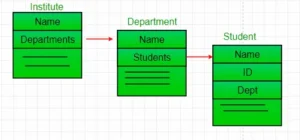
Composition
Composition is a restricted form of Aggregation in which two entities are highly dependent on each other.
- It represents part-of relationship.
- In composition, both entities are dependent on each other.
- When there is a composition between two entities, the composed object cannot exist without the other entity.
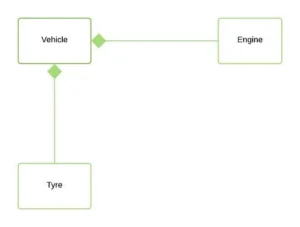
Ex:
1 2 3 4 5 6 7 8 9 10 11 12 13 14 15 16 17 18 19 20 21 22 23 24 25 26 27 28 29 30 31 32 33 34 35 36 37 38 39 40 41 42 43 44 45 46 47 48 49 50 51 52 53 54 55 56 57 58 59 60 61 62 63 64 65 66 67 68 69 70 71 72 73 74 75 76 77 78 79 80 81 82 83 84 85 | // Java program to illustrate // Concept of Composition // Importing required classes import java.io.*; import java.util.*; // Class 1 // Department class class Department { // Attributes of Department public String departmentName; // Constructor of Department class public Department(String departmentName) { this.departmentName = departmentName; } public String getDepartmentName() { return departmentName; } } // Class 2 // Company class class Company { // Reference to refer to list of books private String companyName; private List<Department> departments; // Constructor of Company class public Company(String companyName) { this.companyName = companyName; this.departments = new ArrayList<Department>(); } // Method // to add new Department to the Company public void addDepartment(Department department) { departments.add(department); } public List<Department> getDepartments() { return new ArrayList<>(departments); } // Method // to get total number of Departments in the Company public int getTotalDepartments() { return departments.size(); } } // Class 3 // Main class class CompositonExample { // Main driver method public static void main(String[] args) { // Creating a Company object Company techCompany = new Company("Tech Corp"); techCompany.addDepartment(new Department("Engineering")); techCompany.addDepartment(new Department("Operations")); techCompany.addDepartment(new Department("Human Resources")); techCompany.addDepartment(new Department("Finance")); int d = techCompany.getTotalDepartments(); System.out.println("Total Departments: " + d); System.out.println("Department names: "); for (Department dept : techCompany.getDepartments()) { System.out.println("- " + dept.getDepartmentName()); } } } |
Output:
1 2 3 4 5 6 | Total Departments: 4 Department names: - Engineering - Operations - Human Resources - Finance |
Explanation of the above Program:
In the above example,
- A company can have no. of departments.
- All the departments are part-of the Company.
- So, if the Company gets destroyed then all the Departments within that particular Company will be destroyed, i.e. Departments can not exist independently without the Company.
- That’s why it is composition. Department is Part-of Company.















